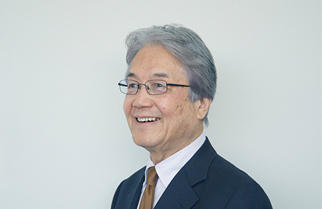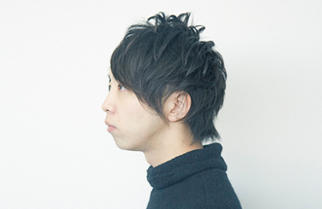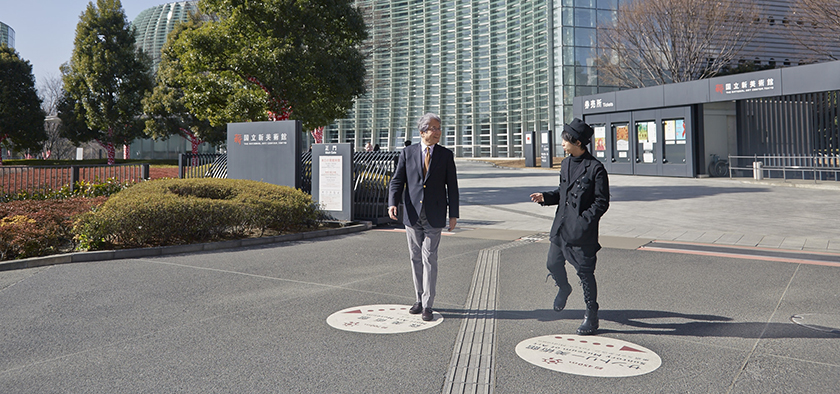
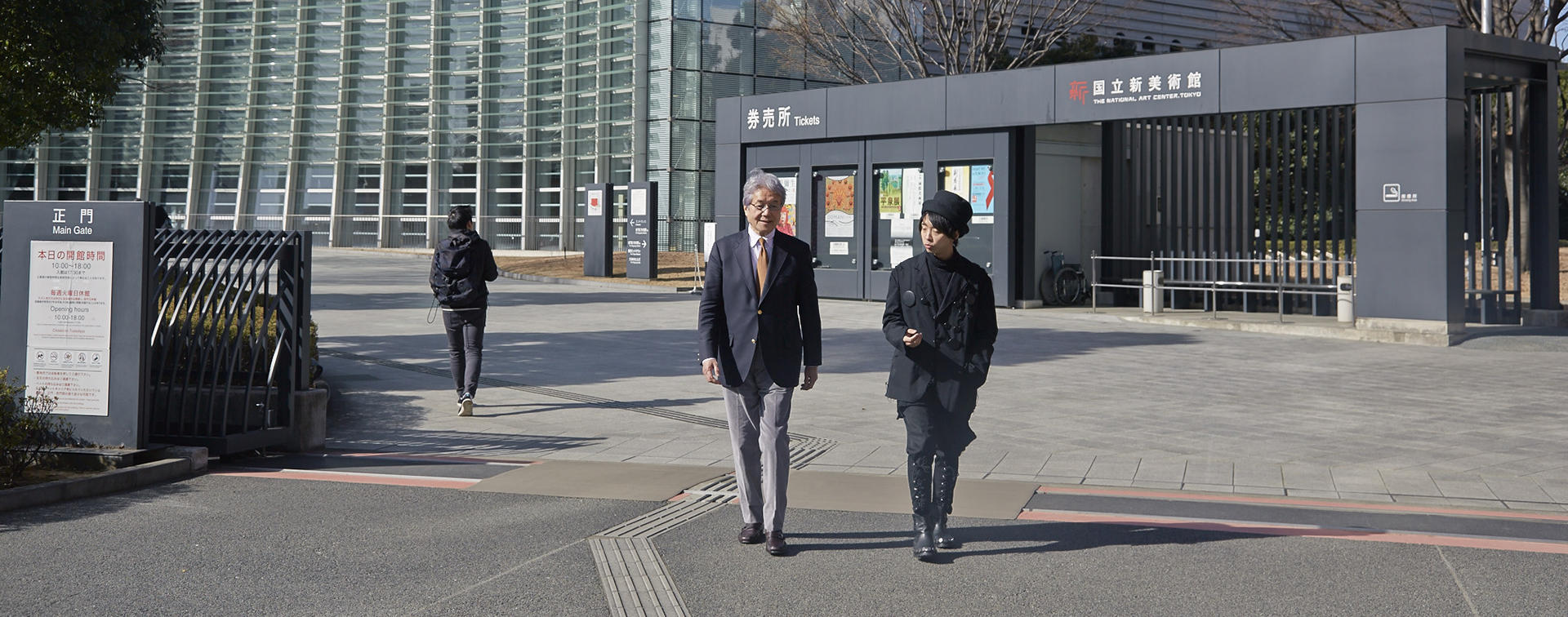

The past decade and the next decade in Roppongi
Aoki:A special zone and cultural rulesto create unique streers Ochiai:Roppongi needs outlandish, scenery-changing artwork
This year marks the 10th anniversary of the Roppongi's "art triangle" of art facilities. In January 2007 the National Art Center, Tokyo was launched, and in March of the same year, the Suntory Museum of Art and 21_21 DESIGN SIGHT were opened. To commemorate the 10th anniversary, we invited Tamotsu Aoki, director of the National Art Center and media artist Yoichi Ochiai - who was born and raised in Ropongi - to hold talks. Both know Roppongi well. They talked about the past and future of the area, as well as the role of art.
A strange area that does not belong to any culture
OchiaiTen years ago when Tokyo Midtown opened, I was 19. It makes me feel nostalgic. I've lived in Roppongi for 29 years now. The atmosphere of the area drastically changed in 2003 around the time Roppongi Hills opened. Roppongi suddenly became very well-known, getting a reputation of being the place where the rich people live.
AokiThe people known as the "Hills zoku" (the Hills tribe).
Ochiai I live in Azabudai which retains the atmosphere from the past, but people in general came to have a very different image of Roppongi. When Tokyo Midtown was built on the grounds of the former Defense Agency, the atmosphere of Roppongi changed yet again and the gap between reality and image seems to have become considerably smaller.
AokiThe area around the Defense Agency was so dark at night.
OchiaiThe Hinokicho Park was like a forest. There was a swamp-like pond where I often went fishing.
AokiI began coming to Ropppongi around the time the Almond shop opened, so perhaps I came here nearly half a century earlier than you did. (laughs) There used to be a Western-style cake shop called near A Lecomte near Meidi-ya store which I liked. I frequently went there to have tea and cake. There were many live houses that performed jazz, so I often came to Roppongi throughout the '70s and '80s.
OchiaiThe backstreets of Meidi-ya store and the backstreets of Don Quijote have a very similar atmosphere. They haven't undergone development, and for me, they are the natural scenery of Roppongi.
If you asked me which place I like best in the world, I would inevitably say Roppongi. The atmosphere is neither Western nor Asian. It doesn't belong to any culture so it's very weird. It's a truly unique place.
A good town is one that is easy to walk around
AokiFrom a cultural viewpoint, the establishment of facilities like the Suntory Museum of Art and 21_21 DESIGN SIGHT has further transformed the image of Roppongi. I've known Roppongi for many years, but I think the place has never been as nice as it is now.
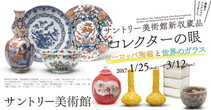
Suntory Museum of Art
Opened in 1961 and transferred in 2007 to its present location in Tokyo Midtown. Has a collection of roughly 3,000 items including national treasures and important cultural properties. Holds exhibitions mainly on Japanese art. "The Collector's Eye: Ceramics from Europe and Glass from Around the World" exhibition was held until March 12 (Sun) 2017.
The streets however, are the one thing that I find unattractive. Whether you are walking from the Roppongi intersection toward Iikura or to the National Art Center, the pedestrian streets are too narrow; there are so many people walking and you can't help bumping into each other. I've always thought that a good town is a town where people can easily walk around.
Ochiai It's also tiresome crossing over from the Roppongi Hills area to the Tokyo Midtown area. In Shibuya for example, there are no such divisions, and the shops are lined seamlessly from Omotesando to Shibuya. In Roppongi though, vacant spaces exist here and there.
AokiThe good thing about Roppongi is that the facilities, including the amusement areas, aren't grouped together in one place. There's a sense of movement, as if nothing ever becomes stagnant. That is precisely why we need streets that allow people to walk with ease. And I think the restaurants and cafes should spread out more onto the pavement. We could also do with a square where people can casually sit.
Before I came here, I used to teach at Aoyama Gakuin University; where the street from Kotto-dori to Shibuya has a wall on one side which becomes pitch-black in the evening. I kept earnestly telling people that the wall should be removed and open-air cafes should be set up, but no one was interested. (laughs) When streets have corners where people can spend their time comfortably, they attract people, and this truth applies to Roppongi too.
Making Roppongi the center of the Asian art market
OchiaiPersonally, I feel that Roppongi should assert itself as a place of international culture. Roppongi is such a distinctive area; it has remnants of both the bubble-era culture and foreign culture. Roppongi should take advantage of its culture and create a story of its own that is very different from other towns.
AokiA few years ago, I wrote a thesis for a magazine on creating a special cultural zone in Roppongi. I proposed creating an area of cultural activity by easing regulation in many areas including tax and encouraging the establishment of cultural facilities, art studios, and offices for anime and manga. Unfortunately, the proposal was not adopted as a policy, but I believe that within Tokyo, there is no other place but Roppongi that will be the fitting location for a 21st century-cultural center.
OchiaiI agree with you. Of all the places in Tokyo, Roppongi has an atmosphere that is most similar to New York. There are so many foreign investment banks and consultant firms in the high-rise buildings; a lot of monetary transaction is taking place, and there are people of many different races.
New York is the center of the world's art market. We might be late in joining the game, but if we were to make an art center in Asia, Roppongi would be the appropriate location. The drawback however, is that there are few art galleries here and not enough places for artists to show their works. And it's difficult for artists to have art studios because of the high rents.
AokiThat is why we need a special zone that will offer lower rates and give artists a certain range of freedom. I'm sure such measures would attract not only Japanese people, but people from abroad.

A need for something so outrageous that it changes the landscape
OchiaiIn the regions, there are art fairs where local communities are closely involved in art, but I think that Roppongi should be more like New York. Enough development has already been made here so what is important now is to think about establishing the area as a place for art culture and art economy; we should be aiming to set standard values in art.
Of course we need cultural facilities like the National Art Center; these are places where the general public encounters art. But we lack places for more edgy art - places where people can look at such works and buy them, snapping up something for around 1 million yen.
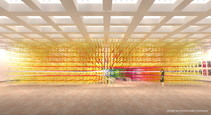
The National Art Center, Tokyo
Opened in January 2007 as Japan's sole national museum without a collection. In January 2017, various events were held to commemorate the 10th anniversary of the museum. Among them was a special exhibition of an installation by Emmanuelle Moureaux.
Photo: Installation of "NACT Colors" to commemorate the 10th anniversary of the National Art Center, Tokyo. Designed by Emmanuelle Moureaux.
AokiThe Kyoto National Museum once held an event that was something like a Cartier's exhibition and sale, and it was apparently a great success. The event was targeted mainly for rich customers. The fact is that the art market cannot grow unless there are individuals who will spend a large amount of money on artwork. In Japan though, there are few rich people who do that and culturally, it's difficult to act in such a privileged way... although that might actually be a good aspect of Japan.
OchiaiI think there must be many rich people living in the Roppongi area who are no longer working for companies and who have billions of yen in cash. If we could engage such people and their communities in a movement aimed at making Roppongi like New York, I feel that things might go well.
AokiIn the future, Tokyo will have to compete with other Asian cities like Beijing and Shanghai, so we need to make streets that are like no other. Tokyo is filled with good restaurants and it's a safe city: it has many merits but at the same time it doesn't have anything attractive that is of a large scale.
OchiaiThat is so. Roppongi doesn't have anything outrageous enough to change the landscape. In other countries, there might be an incredibly huge tower or a town where the first floor of all the buildings are bars. But everything in Roppongi is generally fairly compact.
AokiI'm sure that Roppongi is the ideal place to build the sort of 21st century city that you have in mind, Ochiai-san. That's the reason I decided to accept the position of director of the National Art Center. The art museum is new and has no collection, and I thought it was marvelous. Roppongi is a place that can incorporate new things and pave the way to the future.
The art museum as a work of art in itself
AokiOne of the current trends among art museums worldwide is to regard the buildings of art museums themselves as works of art. The National Art Center was designed by Kisho Kurokawa-san; art museums are competing to commission designs to talented architects. I once saw a group of foreigners taking photos at the main entrance of the building. I went up to them and said, "There's an exhibition being held inside." and they replied, "The inside does not interest us." (laughs)
When the reputation of Guggenheim Museum Bilbao designed by Frank Gehry grew, the Spanish city of Bilbao was born anew and became famous as a cultural city.
OchiaiThat museum is unbelievable, isn't it?! Its silhouette is not normal. It's a shocking building with shiny silver walls whose presence itself transforms an ordinary street into a different world.
AokiIssey Miyake-san once told me that he wanted to build a design museum but that there were few places where new facilities could be built. So I said, "Why not set up huge pillars around the National Art Center and build an art museum on top?" It may sound fantastical but I'm half-serious about it.
OchiaiThere is a building that was built just like that at the University of Tokyo; it's the No.2 building in the Faculty of Engineering where I often took classes as a student. They took advantage of the building that already existed and built a new one on top of it. I think it's a crazy yet sublime design. It's something that can be done.
By the way, of all the new things being built in Roppongi recently, what has mystified me the most is the jet coaster on top of the Don Quijote building. It isn't at all beautiful, but it certainly stands out. When there is a symbolic structure that has enough impact to change the landscape, the atmosphere of a town is changes dramatically.
AokiWhat would you make if you were to build something in Roppongi?
OchiaiSomething that is tall, big, and outlandish - something that nobody has seen before and which cannot be described with words. (laughs)
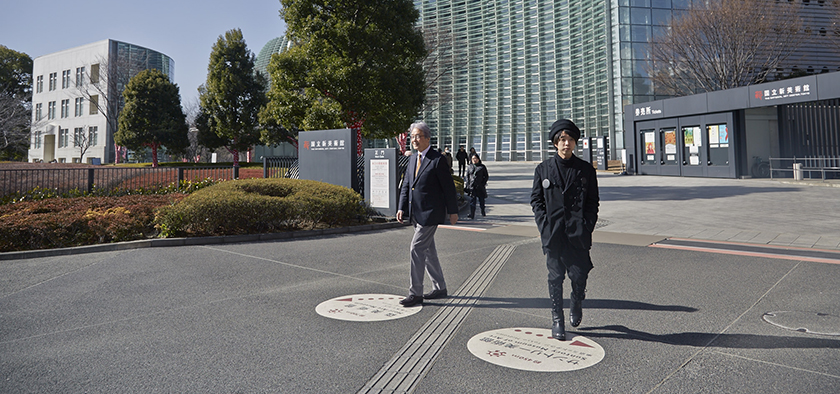
A work to float in the air above the main street
AokiI recently went to Milan and listened to a lecture by the artist Christo for the first time. His works consist of architecture totally wrapped up in cloth; they in fact look really lovely when you look down at them from the sky above. They look very distinct while being a proper part of the scenery at the same time. Apparently, it's difficult to create such works in Japan because of the numerous regulations, but it might be a good idea to do something like that in Roppongi.
OchiaiI would like to draw pictures in the sky. There's a work of mine called "Fairy Lights in Femtoseconds". With more money, I could make a much bigger work. If a rich person would invest a few hundred million yen, I would make a structure that will always be shining and floating above the main street of Roppongi...

Fairy Lights in Femtoseconds
A work where laser-induced plasma emits lights and renders physical aerial graphics. The project was developed in 2015 by Ochiai's research team and attracted wide attention when released on YouTube. In 2016, it won the Prix Ars Electronica Honorary Mention in the interactive art division.
AokiThe community in Roppongi is not tied down by tradition, so it should be fairly easy to carry out such a project.
Ochiai I suppose so. If I made sure not to breach any regulations, the local community will probably not be angry. The jet coaster on top of Don Quixote stopped moving because of opposition, but other things have been accepted. The people in Roppongi are not easily shocked by unusual things. They are open-minded.
AokiThere's a town in India where all the buildings are pink. Perhaps it would be a good idea to have rules such as using only specified colors or making it obligatory for establishments - even chain stores - to have something artistic. So even Starbucks, for example, will have to be ready to comply with the rules when opening a store in Roppongi.
In order to create new things, it is necessary to have cultural rules. In Paris, if you break the window of an apartment, you cannot just mend it anyway you like - there are rules you have to comply with. It's because of such rules that the streets in Paris have an integrated appearance and people from all over the world go to look at them.
Odaiba's Gundam, Roppongi's contemporary art
AokiThe streets of well-known cities like New York are recognizable at a glance. I wish Roppongi could become like that so that when people look at the photos of its streets, they would immediately know it is Roppongi.
OchiaiI agree. If you took photos of the backstreets here, you wouldn't be able to tell whether it's Kabukicho or Roppongi. There is nothing that makes Roppongi identifiable.
AokiIt's such a pity that when you walk to the National Art Center from Tokyo Midtown, the building doesn't come into view. If we had something big like a balloon or Godzilla floating in the air, people will be surprised and think "What on earth is that?" and they will be drawn toward the museum. (laughs)
OchiaiI suppose that Gundam and Godzilla attract people to Odaiba, while it's contemporary art that draw people to Roppongi. In that respect, I think that Mori Building's decision to install Maman (the huge spider statue beside Roppongi Hills) was superb. If it was just that silvery tower standing there, it would have been a dystopic landscape, but that spider is a consoling presence - he seems to know everything.
Increasing the number of weird things in Roppongi
OchiaiIn the past, the notable part of the Roppongi landscape was the Tokyo Tower; now it's Tokyo Midtown and Roppongi Hills, but neither of them is visually outrageous. The streets of Roppongi have become ordinary now; we no longer have the karaoke bar Zone near the Roi Building which had a robot jutting out, and we no longer have Hotel Ibis Roppongi whose first floor had a strange, metallic look. They have all disappeared and can only be seen as images at PokeStops.
The vacant lots are being used mostly for parking bicycles or cars. People ought to realize that using land in that way brings down the value of the area. There should be more weird things in Roppongi!
AokiThe appeal of Roppongi is that you can expect it to have weird things.
OchiaiYou can never expect that in other places. Several redevelopment projects will be underway in the future, so I think something radical and big should be built in line with the projects.
AokiPerhaps it would be interesting if you or other artists held workshops where all kinds of people - from elementary school children to elderly people - give their views on what they think are good and bad scenery for streets.
OchiaiPerhaps. I also have another idea: the billboard advertisement on top of Softbank at the Roppongi intersection is very conspicuous, so I would like to make an installation like the one that Ryoji Ikeda-san made for Times Square. A work that has enough impact to change the landscape will surely change everyone's consciousness.
The role of art as a non-verbal apparatus
OchiaiI think that art plays the role of a non-verbal apparatus. Frank Gehry's buildings, for example, clearly function as non-verbal apparatuses and when they can be seen from every part of the town, they make the town itself a work of art.
Roppongi doesn't have that kind of apparatus yet, so the challenge now is to create many landscapes and to fill the area with installations. We need things that will appeal to everyone regardless of nationality or race. I think such art will be suitable for Roppongi which has an international background.
AokiIt's also important to make it known that things can be seen in Roppongi which cannot be seen anywhere else in the world. Last year, we held the Renoir exhibition. American people often take summer vacations in Europe and go to art museums, and it later occurred to me that we could have put an advert in the New York Times saying, "Come and see Le Moulin de la Galette in Tokyo this summer!"
About 20,000 people from all over the world came to see the Miyake Issey exhibition and I really felt that Tokyo is the center of culture. The number of foreign visitors [per year] to Japan has exceeded 20 million now, and the aim is to increase that number to 30 million and eventually 50 million - we live in such times.
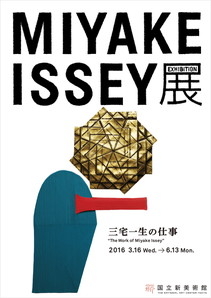
Miyake Issey Exhibition
An exhibition showing works by Issey Miyake over a roughly 45 year-span from 1970 when he began working as a fashion designer. The works are displayed on newly designed mannequins called "Grid Bodies." The exhibition space was designed by Tokujin Yoshioka and Taku Sato. The exhibition was held March-June 2016 at the National Art Center, Tokyo.
Photo: The main image used for the Miyake Issey Exhibition:The Work of Miyake Issey
OchiaiIt's wonderful.
AokiWe also need music. In Paris, there are amateur musicians practicing in the subways, leaving their guitar cases open to receive money. I think we should allow people to do the same in Japan.
OchiaiThe streets are narrow here, but there are quite a lot of unused spaces, so I'm sure it can be done.
Finding new ways to use art museums
AokiPersonally, I think that art museums should not be treated simply as places to look at art. For the Tadao Ando exhibition (in September 2017), plans are underway to replicate the famous Church of the Light at the National Art Center; I'm hoping that after the exhibition is over, the structure can be kept and used for events such as wedding ceremonies.
Weddings are actually held at the Metropolitan Museum of Art. Instead of having a fixed view of what art museums should be like, I think we need to consider all sorts of possibilities. I hope that art museums will be used in different ways in the future.
OchiaiThe installations I make are half-architecture and half-design. My job is not to make things or buildings, but to create structures that lie halfway between object and architecture. So I'm interested in thinking about placing structures and media-oriented works in the streets that will inspire people. I feel that I must do more work in the area of landscape-based art which involves installing huge monuments and electronic billboards.
That's why I'm always looking down at the streets from the observation deck at Roppongi Hills and wondering, "That lot is vacant. I wonder who owns it..."
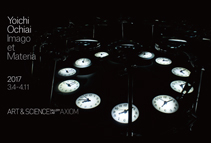
Yoichi Ochiai: Imago et Materia exhibition
An exhibition showing three of Yoichi Ochiai's works including "looking glass 'time' " (shown in photograph) which consists of 12 clocks and lenses which emit light and which create a warped sense of time. The other works are "Zoetrograph" and "Whisper of Spirits." The exhibition will be held at the Art and Science Gallery Lab Axiom in Roppongi until April 11 (Tue) 2017.
Editor's thoughts
Aoki-san and Ochiai-san had a long and interesting conversation. Perhaps this was partly because they both have deep knowledge of Roppongi. (Some of the things they said which couldn't be included here will later be put up on our blog.) A solo exhibition by Ochiai-san is currently being held in Roppongi. We hope readers will visit.(edit_kentaro inoue)




